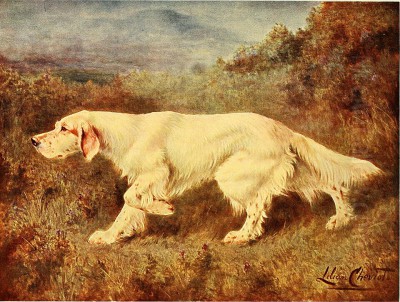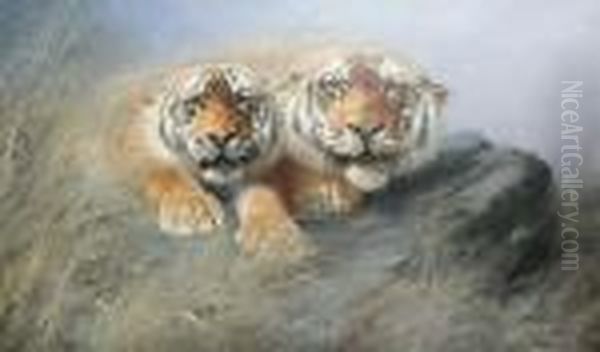
Lilian Cheviot, a notable British artist, carved a distinct niche for herself in the art world of the late nineteenth and early twentieth centuries. Her life, spanning from 1876 to 1936, coincided with a period of rich artistic development and shifting cultural landscapes in Britain. Cheviot was particularly active as a painter between the years 1894 and 1924, a three-decade career during which she focused predominantly on the depiction of animals, with a special affinity for dogs. Her work not only showcases her technical skill but also reflects the era's burgeoning interest in specific animal breeds and the characteristics they were believed to embody.
Biographical Outline and Active Period
Born in 1876, Lilian Cheviot entered a world where opportunities for female artists were gradually expanding, though still fraught with challenges. Information regarding her specific birth date beyond the year 1876 or detailed aspects of her early life and artistic training remains somewhat scarce in readily accessible records. However, her active exhibiting period, documented from 1894 to 1924, confirms her presence and participation in the British art scene. This era, straddling the late Victorian and Edwardian periods and extending into the post-World War I era, was a time of significant artistic diversity, from lingering Pre-Raphaelite influences to the rise of Impressionism and early modernism in Britain.
Cheviot’s decision to specialize in animal painting placed her within a long-standing and popular tradition in British art. Her commitment to this genre over several decades suggests both a personal passion and a recognized talent that found an appreciative audience. She passed away in 1936, leaving behind a body of work that continues to attract interest, particularly among enthusiasts of animal art and collectors of works from her period.
Artistic Focus: The World of Animals

Lilian Cheviot is best remembered for her sensitive and skilled portrayals of animals, especially canines. She demonstrated a keen ability to capture not just the physical likeness of her subjects but also their individual character and spirit. Her oeuvre includes depictions of various dog breeds, with a particular emphasis on those that held cultural significance or embodied certain national ideals in Britain at the time. Bulldogs, Welsh Terriers, and Scottish Terriers feature prominently in her work, often rendered with an understanding that went beyond mere anatomical accuracy.
Her paintings of these breeds sometimes carried undertones of national pride and a sense of steadfastness or defensiveness, qualities often attributed to these particular dogs. This thematic layer added depth to her animal portraiture, aligning it with broader cultural sentiments of the period. Beyond domestic animals, Cheviot also ventured into depicting wilder creatures, as evidenced by works such as "Two Tigers," indicating a versatile talent within the realm of animal art. Her approach was generally rooted in realism, with meticulous attention to detail in fur, musculature, and expression.
Signature Style and Notable Works
Cheviot's artistic style can be characterized by its realistic precision and empathetic portrayal. She employed fine brushwork to render the varied textures of animal coats and the subtle nuances of their expressions. Her compositions were often straightforward, focusing attention directly on the animal subjects, allowing their personalities to take center stage. While primarily a painter, her work also translated into other media, including color prints and lithographs, which would have helped in wider dissemination and appreciation of her art.
One of her most recognized pieces is "Come Over Here!", painted in 1915. This work exemplifies her skill in depicting multiple dog breeds within a single composition, showcasing a Bulldog, a Welsh Terrier, and a Scottish Terrier. The painting not only highlights the distinct physical characteristics and relative sizes of these breeds but also subtly hints at their temperaments and interactions. The title itself suggests a narrative moment, inviting the viewer to engage with the scene.
Another significant work, "Two Tigers" (circa 1900), demonstrates her ability to tackle more exotic and formidable subjects. This painting would have required a different set of observational skills, possibly relying on studies from zoos or other illustrations, and showcases her versatility as an animalier. The rendering of the tigers, their powerful forms and intense gaze, speaks to her capacity to convey the wild essence of her subjects.
The Artistic Milieu: Victorian and Edwardian Britain
Lilian Cheviot practiced her art during a vibrant period in British art history. The late Victorian era saw the continued dominance of narrative painting and realism, with the Royal Academy of Arts playing a central role in the artistic establishment. Animal painting, in particular, had a strong lineage, popularized by artists like Sir Edwin Landseer in the earlier part of the nineteenth century. Landseer’s work, with its often anthropomorphic and sentimental portrayal of animals, had set a high bar and created a lasting public appetite for such subjects.
By the time Cheviot began her career, this interest in animal art was well entrenched. The Edwardian period (1901-1910) and the subsequent years leading up to and following World War I saw a diversification of styles, but traditional forms of representation, including skilled animal portraiture, remained popular. Societies dedicated to various art forms flourished, and opportunities for exhibition, while competitive, were available. For a female artist specializing in animal subjects, Cheviot was part of a respected, if specific, tradition.
Contemporaries and Fellow Artists
Lilian Cheviot was working alongside a multitude of talented artists, some of whom also specialized in animal depiction, while others explored different genres that collectively defined the era's artistic landscape. Understanding her work in context involves acknowledging these contemporaries.
Among those who also focused on animal art was George Edward Lodge (1860–1954), a preeminent illustrator of birds and a respected naturalist. His career largely overlapped with Cheviot's, and his detailed, accurate depictions of avian life were highly regarded. Maud Earl (1863–1943) was another significant contemporary, a fellow female artist who gained international fame for her distinguished dog portraits, often commissioned by royalty and aristocracy. Her style, while also realistic, sometimes possessed a more polished, almost formal quality.
John Emms (1844–1912) was another prominent painter of dogs, particularly hounds and terriers, known for his vigorous brushwork and ability to capture the lively character of his subjects. His active period slightly preceded and overlapped with Cheviot's early career. Arthur Wardle (1860–1949) was an incredibly prolific and versatile animal painter, producing works in oil, watercolor, and pastel, depicting everything from domestic pets to exotic wildlife and prehistoric scenes.
Briton Rivière (1840–1920) was a highly successful artist known for his narrative paintings often featuring animals, sometimes with classical or biblical themes, appealing to the Victorian love for storytelling in art. His work was widely exhibited and reproduced.
In the broader art scene, figures like John Singer Sargent (1856–1925), an American expatriate who became the leading portrait painter of his generation in Britain and America, defined the elegance of the era. While not an animal specialist, his mastery of paint and ability to capture personality were influential. The legacy of the Pre-Raphaelite Brotherhood continued through artists like John William Waterhouse (1849–1917), known for his romantic, classical, and Arthurian subjects, often featuring striking female figures.
Artists specializing in sporting scenes, which frequently included animals, were also part of this milieu. William Henry (dates for the relevant animal artist are less precisely documented but active contemporaneously) specialized in painting sporting dogs and scenes, a popular subgenre. Later, Henry Wilkinson (1921–2011), whose career began towards the end of Cheviot's life and extended much further, became known for his etchings of sporting dogs, including bulldogs, echoing some of Cheviot's subject matter in a different medium.
Further afield, but indicative of the interest in animal and nature art, John Murray Thompson (active as a photographer 1862-1872, though also cited in relation to a painting "Maned Wolf" from a later period) explored wildlife, sometimes focusing on species that were becoming recognized as endangered. This growing awareness of the natural world and its vulnerability was a subtle undercurrent of the times. Other notable British painters of the general period whose work formed the backdrop to Cheviot's career include Sir Lawrence Alma-Tadema (1836-1912) with his detailed scenes of Roman antiquity, and Frederic Leighton (1830-1896), a leading figure of academic classicism.
Lilian Cheviot's Legacy
Lilian Cheviot's contribution to British art lies in her dedicated and skilled portrayal of animals. As a female artist in the late 19th and early 20th centuries, her sustained career in a specialized genre is noteworthy. She captured not only the physical attributes of her subjects but also a sense of their intrinsic character, resonating with a public that held animals, particularly dogs, in high esteem. Her work serves as a visual record of specific breeds and the cultural values associated with them during her time.
While perhaps not as widely known today as some of her more famous contemporaries, Cheviot's paintings are appreciated for their quality, charm, and historical context. They offer a window into the particular affections and aesthetics of Edwardian and early twentieth-century Britain. Her focus on breeds like the Bulldog, Scottish Terrier, and Welsh Terrier, often imbued with a sense of national character, provides a specific cultural snapshot. The survival of her works, including paintings and prints, allows for ongoing appreciation and study.
Conclusion
Lilian Cheviot (1876–1936) remains a figure of interest within the tradition of British animal painting. Her active period from 1894 to 1924 saw her produce a body of work characterized by realistic detail, empathetic understanding of her animal subjects, and a quiet reflection of the cultural values of her time. Through works like "Come Over Here!" and "Two Tigers," she demonstrated her skill and versatility. Situated within a rich artistic environment that included specialists like Maud Earl and George Edward Lodge, as well as broader artistic giants, Cheviot carved out her own space, leaving a legacy that continues to be valued by art lovers and historians interested in the specific contributions of artists to the diverse tapestry of British art. Her paintings endure as a testament to her talent and her affection for the animal kingdom.